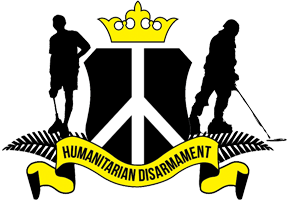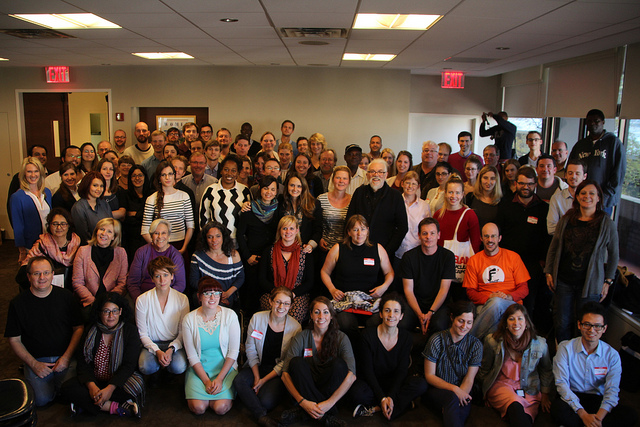A breach of protocol occurred at the United Nations on 21 October, when applause erupted from the civil society gallery high up at the back of the newly renovated meeting room where the General Assembly’s First Committee on Disarmament and International Security was meeting. It came as New Zealand’s Ambassador Dell Higgie read the full list of 124 nations that had endorsed a joint statement expressing support for a humanitarian process on nuclear weapons.
For the International Campaign to Abolish Nuclear Weapons the signatures represented an important validation of the effort to consider the catastrophic humanitarian consequences of the use of nuclear weapons that began in Oslo, Norway in March 2013. Coming mid-point between Oslo and the next meeting in Mexico in February 2014, the First Committee statement was a timely signal of support that the humanitarian process is marching forward, despite a change of the Norwegian government following its general election.
Down the hallway outside the First Committee, two consecutive days of side events on fully autonomous weapons attracted diplomats from more 20 countries as well as the International Committee of the Red Cross. While only six months old, the Campaign to Stop Killer Robots has swiftly gained traction as the issue of retaining human involvement in the decision to target and kill “takes the global stage.”
On 29 October, during the two-hour conventional weapons debate that preceded the long-awaited First Committee session of statements by non-governmental organizations, ten states expressed concern at fully autonomous weapons and urged international action, part of a total of 16 nations that spoke on the topic during First Committee. In total, 30 states have provided their views on the issue since the Human Rights Council debate on 30 May 2013. The campaign now heads back to Geneva for the annual meeting of the Convention on Conventional Weapons, where states will decided on 15 November 2013 whether to approve a mandate proposed by France for international work in 2014.
The link between the protection of civilians and environmental damage during and after conflict was another new item at the First Committee this year, with five states raising the topic during the conventional weapons debate. The Toxic Remnants of War Project prepared an NGO statement on the topic issued together with the International Network on Explosive Weapons, which discussed the need to develop new standards to help progressively reduce the harm from armed violence.
Another global coalition of NGOs that has experienced a historic year is the Control Arms coalition, which entered First Committee after a General Assembly opening that saw dozens more states–including the United States–sign the 2013 Arms Trade Treaty. The campaign scored another success on 18 October when Cambodia became the 114th nation to sign the Arms Trade Treaty and Grenada became the eight signatory to ratify four days later.
Cambodia and Thailand represent two key universalization challenges for advocates of the 2008 Convention on Cluster Munitions. During First Committee, the Cluster Munition Coalition met with several delegations of diplomats, including Syria, Libya and other hold-outs. The coalition’s efforts were boosted on 22 October when the “London 11” Friends of Syria Core Group of countries issued a communique calling on the Syrian regime to end its use of cluster bombs.
Syria’s disarmament diplomats became familiar faces to watchers of the First Committee, as they intervened daily using the country’s “right of reply” to draw attention away from scrutiny of the chemical weapons and other weapons it has used. The ongoing conflict has formed the dominant backdrop for the 2013 session of First Committee.
At a 29 October side event on Syria and chemical weapons, UN disarmament chief Angela Kane described the process that she has in effect led during in her first year on the job, racing under challenging circumstances to gain access, conduct the investigation, do the analysis in less than a month, announce the findings, get the Chemical Weapons Convention accession, and start the destruction process. She said, “it was like we were flying the aircraft while we were assembling it.” The “hardest part” was the team’s inability to provide assistance to victims that were requesting help from them. She said, “we were helpless in seeing the people suffer.”
Libya’s engagement in the 2013 First Committee showed what is possible after conflict ousts a dictator. The 2013 session was chaired Libya’s Permanent Representative to the UN, Ambassador Ibrahim O. Dabbashi. Following outreach by the International Campaign to Ban Landmines and Human Rights Watch, Libya for the first time voted in support of the annual Mine Ban Treaty resolution.
Libya previously abstained from every Mine Ban Treaty resolution between 1998 and 2012 and with each abstention, provided an explanation of its vote that criticized the Mine Ban Treaty and called for it to be rewritten. This time, Libya described the World War II origins of its minefields, but acknowledged that “the problem had been exacerbated since Muammar al-Qadhafi’s forces planted landmines across the country” in 2011.
A total of 154 nations voted for the resolution on the Mine Ban Treaty, which will see Mozambique hold its Third Review Conference in July 2014. In keeping with long-standing tradition, no states voted against the annual Mine Ban Treaty resolution, but 18 abstained, including a small group that has voted against consecutive Mine Ban Treaty resolutions since 1997 (Cuba, Egypt, India, Iran, Israel, Myanmar, Pakistan, Russia, South Korea, Syria, and the US).
All up, the 2013 First Committee was a productive month of successes that has caps off a good year, which started in October 2012 with the first-ever “Humanitarian Disarmament Campaigns Summit” of global coalitions and NGOs working in this field. On 19-20 October 2013, IKV Pax Christi and Article 36 convened a follow-up “campaigns forum” that attracted more than 100 civil society representatives.
The humanitarian disarmament movement has been described as “a winning community.” Its “activists” are not limited to NGO campaigners, but include diplomats, officials, academics, journalists, political leaders and others who are willing to champion human security and the humanitarian perspective in disarmament and arms control efforts.
Photo: 2013 Humanitarian Disarmament Campaigns Forum participants (c) Cris Wittman, 20 October 2013
For more information, please see:
- Reaching Critical Will website on First Committee
- Article 36 statement and chart on humanitarian disarmament (21 October)
- Campaign to Stop Killer Robots side event and media coverage, and statements (29 October)
- Photographs and Video of NGO statements to First Committee (29 October)
- Photographs from the Humanitarian Disarmament Campaigns Fourm (19-20 October)
- Report of the 2012 Humanitarian Disarmament Campaigns Summit hosted by Human Rights Watch


Leave a Reply